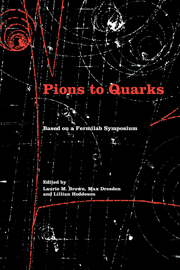Book contents
- Frontmatter
- Contents
- List of contributors
- Foreword by Leon M. Lederman
- Editors' acknowledgments
- Photographs of the symposium
- List of abbreviations
- List of notation
- I Introduction
- II Particle discoveries in cosmic rays
- III High-energy nuclear physics
- IV The new laboratory
- V The strange particles
- VI Weak interactions
- VII Weak interactions and parity nonconservation
- VIII The particle physics community
- 34 The postwar political economy of high-energy physics
- 35 The history of CERN during the early 1950s
- 36 Arguments pro and contra the European laboratory in the participating countries
- 37 Physics and the excellences of the life it brings
- 38 Social aspects of Japanese particle physics in the 1950s
- IX Theories of hadrons
- X Personal overviews
- Name index
- Subject index
34 - The postwar political economy of high-energy physics
Published online by Cambridge University Press: 07 May 2010
- Frontmatter
- Contents
- List of contributors
- Foreword by Leon M. Lederman
- Editors' acknowledgments
- Photographs of the symposium
- List of abbreviations
- List of notation
- I Introduction
- II Particle discoveries in cosmic rays
- III High-energy nuclear physics
- IV The new laboratory
- V The strange particles
- VI Weak interactions
- VII Weak interactions and parity nonconservation
- VIII The particle physics community
- 34 The postwar political economy of high-energy physics
- 35 The history of CERN during the early 1950s
- 36 Arguments pro and contra the European laboratory in the participating countries
- 37 Physics and the excellences of the life it brings
- 38 Social aspects of Japanese particle physics in the 1950s
- IX Theories of hadrons
- X Personal overviews
- Name index
- Subject index
Summary
Six billion dollars will buy two nuclear powered aircraft carriers, 19 months of research on the Star Wars antimissile system – or the ultimate dream machine for the 2,000 or so high-energy physicists in the United States. It is a particle accelerator – an “atom smasher” in the old vernacular – and if funded would be the biggest machine ever built … Physicists say the machine would help them fathom such basics as the nature of matter and the origin of the universe. But the government may well balk at spending such a sum for a device that produces mere scientific findings.
This statement, from Newsweek (22 April 1985), epitomizes the political economy of postwar high-energy physics. Its practitioners have had to allege that more than “mere scientific findings” will result from the construction of their atom smashers – the ultimate dream machine has changed with time – in order to satisfy their federal patrons. The increasingly energetic and costly machines built since the war have testified to the physicists' success in linking their own with the national purpose. There has been, inevitably, a trade-off between scholarly and state purposes that can be understood by an historical analysis of the political economy of high-energy physics in the late 1940s and early 1950s, when the modern patterns of patronage of particle physics first manifested themselves.
- Type
- Chapter
- Information
- Pions to QuarksParticle Physics in the 1950s, pp. 497 - 507Publisher: Cambridge University PressPrint publication year: 1989
- 3
- Cited by



